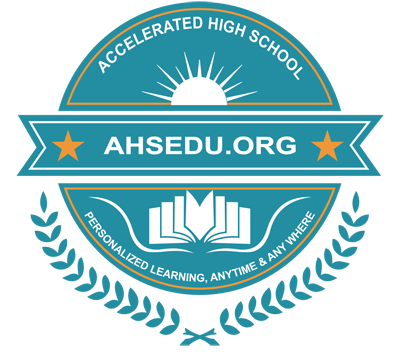Accelerated High School
Standardized Curriculum of General Mathematics-II
Mathematical knowledge and skills are essential for navigating the complexities of the 21st century. Understanding and applying mathematical concepts is crucial for personal decision-making, civic participation, and career readiness. Accelerated High School (AHS) aligns its curriculum with various educational standards to ensure comprehensive coverage of mathematical principles and their practical applications.
Mission:
All students will understand the mathematical concepts and processes required for personal decision-making, participation in civic life, and preparation for future academic and career pursuits.
Vision:
Prepare students to become mathematically literate individuals who can effectively:
- Apply mathematical thinking and skills to solve real-world problems.
- Engage in logical reasoning and develop problem-solving strategies.
- Conduct investigations, analyze data, and interpret results.
- Discuss mathematical concepts and their applications.
- Read and evaluate multiple sources of mathematical information.
- Communicate mathematical ideas through various forms, including reports, presentations, and visual displays.
Spirit and Intent:
The AHS mathematics curriculum has been prepared and standardized following The New Jersey Student Learning Standards (NJSLS), including the Student Learning Standards for Career Readiness, Life Literacies, and Key Skills, as well as the Student Learning Standards for Personal Financial Literacy. These standards outline the expectations for what students should know and be able to do, promoting a comprehensive approach to mathematical instruction. From the earliest grades, students are expected to engage in learning experiences that develop their understanding of mathematical concepts, improve their problem-solving skills, and enhance their ability to apply mathematics in various contexts.
Four Dimensions of AHS Mathematics Curriculum:
In Grade 2, instructional time should focus on four critical areas:
(1) extending understanding of base-ten notation;
(2) building fluency with addition and subtraction;
(3) using standard units of measure;
(4) describing and analyzing shapes.
(1) Students extend their understanding of the base-ten system. This includes ideas of counting in fives, tens, and multiples of hundreds, tens, and ones, as well as number relationships involving these units, including comparing. Students understand multi-digit numbers (up to 1000) written in base-ten notation, recognizing that the digits in each place represent amounts of thousands, hundreds, tens, or ones (e.g., 853 is 8 hundreds + 5 tens + 3 ones).
(2) Students use their understanding of addition to develop fluency with addition and subtraction within 100. They solve problems within 1000 by applying their understanding of models for addition and subtraction, and they develop, discuss, and use efficient, accurate, and generalizable methods to compute sums and differences of whole numbers in base-ten notation, using their understanding of place value and the properties of operations. They select and accurately apply methods that are appropriate for the context and the numbers involved to mentally calculate sums and differences for numbers with only tens or only hundreds.
(3) Students recognize the need for standard units of measure (centimeter and inch) and they use rulers and other measurement tools with the understanding that linear measurement involves an iteration of units. They recognize that the smaller the unit, the more iterations they need to cover a given length.
(4) Students describe and analyze shapes by examining their sides and angles. Students investigate, describe, and reason about decomposing and combining shapes to make other shapes.
Curriculum for Grade-II Mathematics
Standard 1: Number and Operations in Base Ten
Learning Objectives:
- Count to 120, starting at any number less than 120. In this range, read and write numerals and represent a number of objects with a written numeral.
- Understand that the three digits of a three-digit number represent amounts of hundreds, tens, and ones; e.g., 706 equals 7 hundreds, 0 tens, and 6 ones. Understand the following as special cases: a. 100 can be thought of as a bundle of ten tens — called a “hundred.” b. The numbers 100, 200, 300, 400, 500, 600, 700, 800, 900 refer to one, two, three, four, five, six, seven, eight, or nine hundreds (and 0 tens and 0 ones).
- Count within 1000; skip-count by 5s, 10s, and 100s.
- Read and write numbers to 1000 using base-ten numerals, number names, and expanded form.
- Compare two three-digit numbers based on meanings of the hundreds, tens, and ones digits, using >, =, and < symbols to record the results of comparisons.
- Use place value understanding and properties of operations to add and subtract.
- Fluently add and subtract within 100 using strategies based on place value, properties of operations, and/or the relationship between addition and subtraction.
- Add up to four two-digit numbers using strategies based on place value and properties of operations.
- Add and subtract within 1000, using concrete models or drawings and strategies based on place value, properties of operations, and/or the relationship between addition and subtraction; relate the strategy to a written method. Understand that in adding or subtracting three-digit numbers, one adds or subtracts hundreds and hundreds, tens and tens, ones and ones; and sometimes it is necessary to compose or decompose tens or hundreds.
Topics of AHS-GM:
Counting:
- Hundred charts
- Number lines - up to 100
- Number lines - up to 1,000
- Count forward - up to 1,000
Name of numbers:
- Spell word names for numbers up to 20
- Writing numbers up to 100 in words - convert words to digits
- Writing numbers up to 100 in words - convert digits to words
- Writing numbers up to 1,000 in words - convert words to digits
- Writing numbers up to 1,000 in words - convert digits to words
- Roman numerals I, V, X
Even and odd:
- Even or odd number of shapes - up to 20
- Identify even and odd numbers - up to 20
- Even or odd numbers on number lines
- Identify even and odd numbers - up to 100
- Select even and odd numbers - up to 100
Place Value:
- Place value models - tens and ones
- Place value models - up to hundreds
- Place value models - up to thousands
- Identify a digit up to the hundreds place
- Value of a digit - tens and ones
- Value of a digit - up to hundreds
- Value of a digit - up to thousands
Addition Strategies:
- Add one-digit numbers
- Add three one-digit numbers
- Add four or more one-digit numbers
- Add two-digit numbers - sums to 100
- Add four numbers up to two digits each
- Add three or four numbers vertically - up to two digits each
Subtraction Strategies:
- Subtract a one-digit number from a two-digit number
- Subtract two-digit numbers vertically
- Subtract from three-digit numbers vertically
Standard 2: Operations and Algebraic Thinking
Learning Objectives:
- Represent and solve problems involving addition and subtraction.
- Use addition and subtraction within 100 to solve one- and two-step word problems involving situations of adding to, taking from, putting together, taking apart, and comparing, with unknowns in all positions, e.g., by using drawings and equations with a symbol for the unknown number to represent the problem.
Topics of AHS-GM:
Mixed Operation:
- Relate addition and subtraction sentences - up to two digits
- Complete the addition or subtraction sentence - up to 100
Standard 3: Measurement and Data
Learning Objectives:
- Work with time. Tell and write time from analog and digital clocks to the nearest five minutes, using a.m. and p.m.
- Represent and interpret data.
Topics of AHS-GM:
Time:
- Match digital clocks and times
- Match analog clocks and times
- Match analog and digital clocks
- Read clocks and write times: hour and half hour
- Read clocks and write times
- A.M. or P.M.
- Compare clocks
Calendars:
- Months of the year
- Read a calendar I
- Read a calendar II
Standard 4: Geometry
Learning Objectives:
- Partition circles and rectangles into two, three, or four equal shares, describe the shares using the words halves, thirds, half of, a third of, etc., and describe the whole as two halves, three thirds, four fourths. Recognize that equal shares of identical wholes need not have the same shape.
Topics of AHS-GM:
Fractions:
- Equal parts
- Identify halves
- Identify thirds
- Identify fourths
- Identify halves, thirds, and fourths







